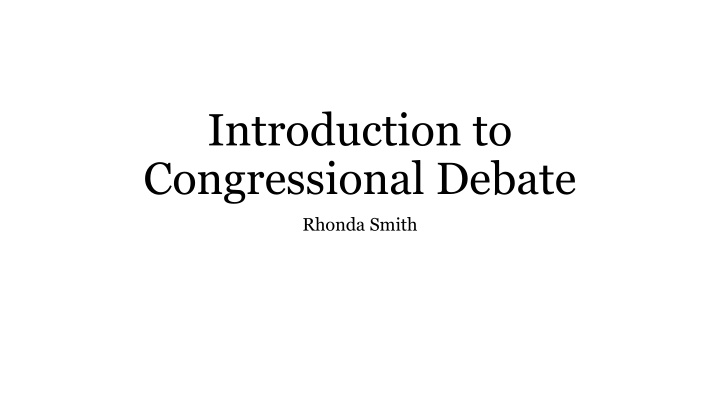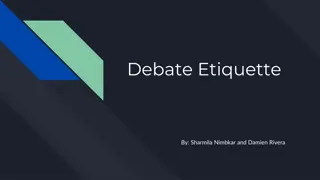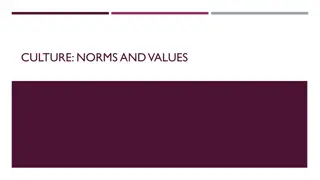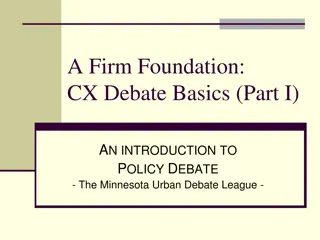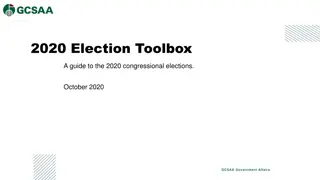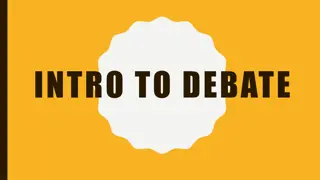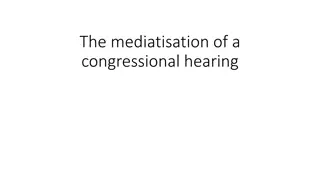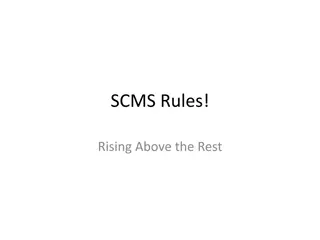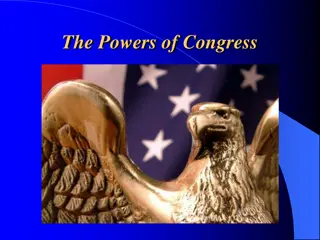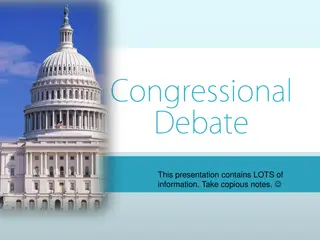Essentials of Congressional Debate: Rules, Procedures, and Norms
Explore the key components of Congressional Debate including the types of legislation, preparation guidelines, contest norms, and dress code expectations. Learn about bills, resolutions, and constitutional amendments, and understand the importance of courteous behavior, proper attire, and effective argumentation. Dive into the world of Congressional Debate to enhance your critical thinking skills and legislative acumen.
Download Presentation

Please find below an Image/Link to download the presentation.
The content on the website is provided AS IS for your information and personal use only. It may not be sold, licensed, or shared on other websites without obtaining consent from the author.If you encounter any issues during the download, it is possible that the publisher has removed the file from their server.
You are allowed to download the files provided on this website for personal or commercial use, subject to the condition that they are used lawfully. All files are the property of their respective owners.
The content on the website is provided AS IS for your information and personal use only. It may not be sold, licensed, or shared on other websites without obtaining consent from the author.
E N D
Presentation Transcript
Introduction to Congressional Debate Rhonda Smith
Good Legislation Debatable on both sides Interesting Encourages critical thinking Is current and fresh National jurisdiction Is written concisely and grammatically correct with clear intent Is the original work of the submitting school
Bill If passed, a bill becomes law. Details how a law will work including when it takes affect who enforces it how infractions are handled how it is funded
Resolution A resolution is simply a statement of position on an issue, usually that is not in the jurisdiction of Congress. Examples: foreign issue, recommendation to another party, encouraging/funding research Includes scope of the problem along with the need for a solution
Constitutional Amendment Proposes an amendment to the United State Constitution
Preparation Brainstorm arguments for legislation. Research look for warrants to support ideas. Build files for each piece of legislation with arguments on both sides of the issue. Practice rounds in class. Make outlines/notes for rounds
Contest Materials Dress Norms
Norms Be courteous. Stand to be recognized. Introduce self and ensure judges, PO and parliamentarian are ready before beginning. Use a legal pad for reference if needed. Refer to other competitors as Representative [last name]. Use time wisely. Previous question should be called after everyone has had the opportunity to speak, time has elapsed, or arguments are stale. Tabling legislation should be used for very limited purposes and not to deny legislators the opportunity to speak on the legislation. *Watch at least one round in class to give students the opportunity to know what to expect so they will feel more comfortable.
Dress Appropriately Suits and Ties Shoes Skirts Hose Low Heel or Flat Color Jewelry Hair
Materials in round Placard Precedence chart Legislation Charged computer Outlines and legal pad Pens Table of Motions Gavel if planning to run for PO Robert s Rules of Order/Rules
Rules Disable WiFi If used, visual aids must be left for the chamber throughout the round and made available for use by all members. Congress rounds are open chamber, but students must motion for personal privilege and receive permission from the PO. Minimize time away from chamber. Do not interrupt speeches.
Overview of Competition Oath of office Rules of the day Agenda Presiding Officer auditions Round
Parliamentary Procedure Set the agenda Set the length of debate on each item Use motions to progress business and maintain fairness.
Roles Representative competitors are recognized as representatives. Parliamentarian ensures rules are procedures are followed correctly Presiding Officer responsible for ensuring the session runs smoothly. Calls on speakers, keeps precedence, should be familiar with parliamentary procedure and rules.
Presiding Officer (PO) Should be referred to as Madam/Mister Chair Gavel Signals cue representatives. It is recommended that the PO review their gavel procedures after starting the session. Example: 1 strong tap = call meeting to order; also used to end questioning time (presiding officer also may gesture a cue to questioners to be seated as the speaker finishes answering the final question) Speech time signals: 1 tap when 1 minute remains 2 taps when 30 seconds remains 3 taps when 5 seconds remain Verbal stop when time has lapsed Representatives may appeal the decision of the chair, which requires a second and a majority vote, but this action should be reserved for only the most egregious acts and should always be preceded with the motion point of order to allow the chair the opportunity to reconsider on his/her own. UIL Handbook
Recognizes representatives for speeches/questions/motions Precedence number of opportunities to speak Recency who spoke first Before precedence is set, use geography of the chamber. That is, s/he should not choose only from one location of the chamber or from one school known to him/her or from one conference known to him/her. After each speech, state the time for the speech and ask questioners to rise. Follow the agenda set at the beginning of the round. Ensure order in the chamber through motions/seconds.
Voting Procedures Maintain a count of votes (negative votes and abstentions are only counted for recorded votes such as legislation). Voice Vote "On the motion to [read the motion title] those in favor, say aye. (Pause) Those opposed, say nay." If result is unclear or division of the chamber is called, a standing vote is taken. Unrecorded vote Rising Vote "Those in favor of the motion to [read the motion title] will rise [Count vote.] "Be seated. Those opposed will rise." [Count vote.] "Be seated." Calling for abstentions is only necessary on main motions/legislation. Announcing the Result: On the motion to Voice Vote "The ayes have it and the motion is adopted or This motion carries. or This motion fails Counted Rising Vote "With a vote of # in the affirmative and # in the negative, the affirmative/opposition has it and the motion carries/fails."
No amendment shall seek to alter the fundamental intent of the legislation. There is no guarantee of a speech. Upon a one-third vote of the chamber, a delegate may move the question, or the PO may call for speeches in affirmation of the amendment. The amending legislator is not guaranteed this privilege; it is based on precedence and recency. Amendment speeches shall count toward precedence and recency.
Parliamentarian Only intervenes when necessary. Considers amendments Amendments and amendments to amendments must be presented, written on the appropriate form, to the Parliamentarian first, who shall solely determine the appropriateness of the amendment offered. After the Parliamentarian either approves or disapproves the amendment, they will pass the amendment to the chair, who shall recognize the author of the amendment at the earliest possible time for his/her motion to amend.
Know the Rules Knowing how to follow parliamentary procedure will prevent embarrassing mistakes. Practice this in class. Print and have accessible a Table of Frequently Used Motions. Read the rules UIL/NSDA/TFA/etc. have minor rule differences that can have big implications. Precedence when to speak. Gavel signals for PO
Speeches Authorship/Sponsorship 3 minutes w/ 2 minutes of direct questioning Opposing speech first one is 3 minutes w/2 minutes of direct questioning All other speeches are 3 minutes with one minute of questioning
Speech Format Introduction (15 to 30 seconds) includes AGD and preview of main points, usually two is best. Body (2:00 to 2:30) State main points beginning with a short thesis statement. Include analytical and empirical evidence to warrant the claims made in each point. Both quantitative statistics/facts and qualitative case studies are excellent to warrant arguments. Be sure to state the importance/impact of the point and why it supports or opposes the legislation being debated. Conclusion (about 15 seconds) restate primary points and urge body to pass or fail the legislation.
Asking Questions Ask meaningful questions. Establish a flow of questions that lead to a climax or overall point. Keep questions short.
Answering Questions Be clear, concise and complete. Be professional. Citations Reference previous speakers Be truthful
Politicking fairness Make friends congressional debate is a social game. Be communicative what do you want and why. Stay in the loop by going outside your comfort zone. Facebook groups and off-time meetings.
Non-verbals It starts when you get to tournament. How to begin. OWN IT! Facial expressions Gestures Movement Pay attention throughout round prep before the round Leaving the chamber Respectfulness with personality v. aggression Appearance
